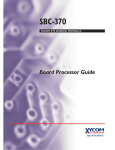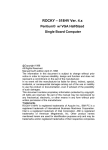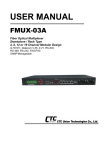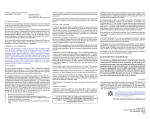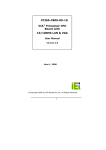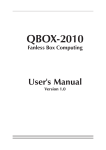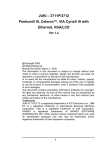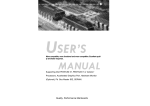Download ROCKY – P258BX (Ver. 5.x) 600MHz Pentium II
Transcript
ROCKY – P258BX (Ver. 5.x) 600MHz Pentium® II / III Single Board Computer ©Copyright 1999 by ICP Electronics Inc. All Rights Reserved. Manual second edition Aug.01, 1999. The information in this document is subject to change without prior notice in order to improve reliability, design and function and does not represent a commitment on the part of the manufacturer. In no event will the manufacturer be liable for direct, indirect, special, incidental, or consequential damages arising out of the use or inability to use the product or documentation, even if advised of the possibility of such damages. This document contains proprietary information protected by copyright. All rights are reserved. No part of this manual may be reproduced by any mechanical, electronic, or other means in any form without prior written permission of the manufacturer. Trademarks ROCKY-P258BX is a registered trademark of ICP Electronics Inc. IBM PC is a registered trademark of International Business Machines Corporation. Intel is a registered trademark of Intel Corporation. AMI is a registered trademark of American Megatrends, Inc. Other product names mentioned herein are used for identification purposes only and may be trademarks and/or registered trademarks of their respective companies. Contents 1. Introduction .......................................................................3 1.1 Specifications .............................................................................. 4 1.2 What You Have ........................................................................... 5 2. Installation.........................................................................6 2.1 ROCKY-P258BX's Layout ............................................................ 7 2.2 Unpacking Precautions………………………………………………...8 2.3 Setting the CPU of ROCKY-P258BX ........................................... 9 2.4 Voltage Setting for PCI Reset.................................................... 10 2.5 Watch-Dog Timer ...................................................................... 10 2.6 DiskOnChip™ Flash Disk............................................................ 11 2.7 Clear CMOS Setup .................................................................... 11 2.8 PS/2 Mouse .............................................................................. 11 3. Connection......................................................................12 3.1 Floppy Disk Drive Connector...................................................... 12 3.2 PCI E-IDE Disk Drive Connector ................................................ 13 3.3 Parallel Port............................................................................... 14 3.4 Serial Ports................................................................................ 15 3.5 Keyboard / MouseConnector...................................................... 15 3.6 External Switches and Indicators ............................................... 16 3.7 USB Port Connector .................................................................. 17 3.8 IrDA Infrared Interface Port ....................................................... 17 3.9 Fan Connector .......................................................................... 18 4. AMI BIOS Setup..............................................................19 1 4.1 Getting Start .............................................................................. 19 4.2 Standard CMOS Setup .............................................................. 20 4.3 Advanced CMOS Setup ............................................................. 21 4.4 Advanced Chipset Setup............................................................ 23 4.5 Power Management Setup ........................................................ 25 4.6 PCI/PLUG AND PLAY Setup...................................................... 26 4.7 Peripheral Setup ........................................................................ 27 4.8 Hardware Monitor Setup ........................................................... 29 4.9 Change Supervisor/User Password…………………………….. ......................... 30 4.10 Auto-Detect Hard Disk….............................................................. 31 4.11 Auto Configuration with Optimal Settings ................................... 31 4.12 Auto Configuration with Fail Save Settings................................. 32 4.13 Save Settings and Exit ............................................................... 32 4.14 Exit Without Saving ................................................................... 32 2 5. E Key Function ...............................................................33 Appendix A. Watch-Dog Timer ...........................................35 Appendix B. ATX Power Supply..........................................36 Appendix C. I/O Information…..............................................37 2 1 Introduction ® Welcome to the ROCKY-P258BX Pentium II / III Single Board Computer. The ROCKY-P258BX is a PICMG bus form factor ® board. It is equipped with high performance Pentium II / III Processor and advanced high performance multi-mode I/O, designed for the system manufacturers, integrators, or VARs that want to provide all the performance, reliability, and quality at a reasonable price. This board has a built-in DiskOnChip™(DOC) Flash Disk socket for embedded application. The DOC Flash Disk is software compatible to hard disk. User can use any DOS command without any extra software utility. The DOC currently is available from 2MB to 72MB. An advanced high performance super AT I/O chip – Winbond W83977TF is used in the ROCKY-P258BX board. The on-chip UARTs are compatible with the NS16C550. The parallel port and IDE interface are compatible with IBM PC/AT architecture. ROCKY-P258BX uses the advanced INTEL AGPset 82443BX Host Bridge Chipset, which is 100% ISA/PCI compatible chipset with PCI 2.1 standard. More detail specifications of ROCKY-P258BX are listed on the next page. 3 1.1 Specifications : • Processor: Single Slot 1 socket supports Intel Pentium® II/III up to 600Mhz Processor • System Memory : four 168-pin DIMM sockets, support up to 1GB SDRAM • Chipset: Intel AGPset 82443BX Host Bridge, provides a Host-toPCI bridge, optimized DRAM controller & data path and an Accelerated Graphic Port (AGP) interface. • Bus Interface: ISA bus and PCI 32-bit local bus, PCI 2.1 standard • DMA channels : 7 • Interrupt levels : 15 • Real Time Clock and battery backup : ST M4T28 Time Keeper (Lithium Battery) for data retention up to ten years. • Ultra DMA/33 IDE Interface : up to four PCI Enhance IDE hard drives. The Ultra DMA/33 IDE can handle data transfer up to 33MB/s. The best of all is that this new technology is compatible with existing ATA-2 IDE specifications. So, there is no need to do any change for customer’s current accessory. • Multi I/O Chip: W83977, all I/O setup by BIOS • On Board I/O: 1 Floppy Port (up to 2.88MB, 3 mode) 2 Serial Ports (2F8, 3F8) 1 Parallel Port (ECP, EPP port) FIR TX/RX Header (3E8) • USB port: one USB port on iron plate. • Built-in LM78 Hardware Monitoring System to monitor power supply voltage and CPU Fan rpm status. • Watch-dog timer : can be set by 1, 2, 10, 20, 110 or 220 seconds period. Reset or NMI is generated when CPU does not periodically trigger the timer. Your program uses hex 043 and 443 to control the watch-dog and generate a system reset. 4 • ISA PLUS : designed to enhance the ISA bus drive capability • E Key (optional): A special designed 1-Kbit EEPROM provided to accept read/write data by customer’s program. Because of it’s nonvolatile characteristic, It is very useful to store system ID, Password, Critical Data, etc. • Flash Disk - DiskOnChip™ : The built-in True FFS Transparent Flash Block Management and Space Reclamation will let customer to use the Flash Disk with DOS command, no need any extra software utility. • PS2 Mouse / Keyboard Port on-board. • Power Consumption : [email protected] +12V@120mA , -12V@50mA TM 2 TM (PII 450MHz CPU and 512MB DRAM) • 1.2 Operating Temperature : 0° ~ 55° C ( CPU needs Cooler) What You Have In addition to this User's Manual, the ROCKY-P258BX package includes the following items: • ROCKY-P258BX (Ver. 5.x) Single Board Computer • Parallel Ribbon Cable and Port Bracket • FDD/HDD Cable Sets • 6-pin Mini-Din to one 5-pin Mini-Din for Keyboard and one 6pin Mini-Din for PS/2 Mouse Adapter Cable. • one support disk contains of the needed driver If any of these items is missing or damaged, contact the dealer from whom you purchased the product. Save the shipping materials and carton in case you want to ship or store the product in the future. 5 2 Installation This chapter describes how to install the ROCKY-P258BX. The layout of ROCKY-P258BX is shown on the next page and the Unpacking Precautions that you should be careful with are described on the following page. Also included is the jumpers and switches setting for this board’s configuration, such as: CPU type selection, system clock setting and Watchdog timer. 2.1 ROCKY–P258BX's Layout < please, refer to the next page > 6 2.1 ROCKY–P258BX's Layout 7 2.2 Unpacking Precautions Some components on ROCKY-P258BX SBC are very sensitive to static electric charges and can be damaged by a sudden rush of power. To protect it from unintended damage, be sure to follow these precautions: ü Ground yourself to remove any static charge before touching your ROCKY-P258BX SBC. You can do it by using a grounded wrist strap at all times or by frequently touching any conducting materials that is connected to the ground. ü Handle your ROCKY-P258BX SBC by its edges. Don’t touch IC chips, leads or circuitry if not necessary. ü Do not plug any connector or jumper while the power is on. ü Do not put your ROCKY-P258BX SBC unprotected on a flat surface because it has components on both sides. 8 2.3 Setting the CPU of ROCKY-P258BX OFF ON • JP4, JP3 : CPU FREQUENCY SELECT JP4 FS2 2-3 1-2 BUS FREQUENCY 66MHz 100MHz JP3 FS1 1-3 1-3 FS0 2-4 2-4 • JP2 : CPU Multiplier Setting : Ratio 3.0 x 3.5 x 4.0 x 4.5 x 5.0 x 5.5 x 6.0 x 6.5 x 1-2 ON ON OFF OFF OFF OFF ON ON 3-4 OFF OFF ON ON OFF OFF ON ON 5-6 ON OFF ON OFF ON OFF ON OFF 9 7-8 ON ON ON ON ON ON OFF OFF 2.4 Voltage Setting for PCI Reset • JP5 : PCI Reset Voltage (This is factory setting jumper) PIN NO. 1-2 2-3 2.5 DESCRIPTION 5V 3.3 V Watch-Dog Timer The Watch-Dog Timer is enabled by reading port 443H. It should be triggered before the time-out period ends, otherwise it will assume the program operation is abnormal and will issue a reset signal to reboot or activate NMI to CPU. The Watch-Dog Timer is disable by reading port 043H. • JP12 : Watch-Dog Timer Type Setting PIN NO. 1-2 2-3 DESCRIPTION NMI RESET • JP13 : WDT Time-out Period PERIOD 1 sec. 2 sec. 10 sec. 20 sec. 110 sec. 220 sec. 1-2 OFF OFF OFF OFF ON ON 3-4 OFF OFF ON ON OFF OFF 5-6 ON ON OFF OFF OFF OFF 10 7-8 OFF ON OFF ON OFF ON 2.6 DiskOnChip™Flash Disk The DOC is software compatible to hard disk and DOS. Customer doesn‘t need an y extra software utility. The DOC occupies 8KB of memory address. It is just “plug and play”, easy and reliable. Right now, the DOC is available from 2MB to 72MB. • JP7 : DiskOnChip™Memory Address Setting PIN NO. 1-2 3-4 5-6 2.7 ADDRESS CE000 – CFFFF D6000 – D7FFF DE000 – DFFFF Clear CMOS Setup If you forget the CMOS password, you can clear or reset it by closing the JP8 for about 3 seconds then open again. Now, the password has been cleared from your CMOS. Set it back to normal operation mode by opening it. • JP8 : Clear CMOS Setup JP8 ON OFF 2.8 DESCRIPTION CLEAR CMOS NORMAL OPERATION PS/2 Mouse • JP6 : PS/2 Mouse Setting The PS/2 mouse uses IRQ12 while in operation. JP6 ON OFF DESCRIPTION Enable the PS/2 Mouse, IRQ12 Disable the PS/2 Mouse 11 3 Connection This chapter describes how to connect peripherals, switches and indicators to the ROCKY- P258BX board. 3.1 Floppy Disk Drive Connector ROCKY-P258BX board is equipped with a 34-pin daisy-chain driver connector cable. • CN8 : FDC CONNECTOR PIN NO. DESCRIPTION 1 GROUND 3 GROUND 5 GROUND 7 GROUND 9 GROUND 11 GROUND 13 GROUND 15 GROUND 17 GROUND 19 GROUND 21 GROUND 23 GROUND 25 GROUND 27 GROUND 29 GROUND 31 GROUND 33 GROUND PIN NO. 2 4 6 8 10 12 14 16 18 20 22 24 26 28 30 32 34 12 DESCRIPTION REDUCE WRITE N/C N/C INDEX# MOTOR ENABLE A# DRIVE SELECT B# DRIVE SELECT A# MOTOR ENABLE B# DIRECTION# STEP# WRITE DATA# WRITE GATE# TRACK 0# WRITE PROTECT# READ DATA# SIDE 1 SELECT# DISK CHANGE# 3.2 PCI E-IDE Disk Drive Connector You can attach four IDE (Integrated Device Electronics) hard disk drives to the ROCKY-P258BX IDE controller. • CN7/CN6 : Primary/Secondary IDE Interface Connector PIN NO. 1 3 5 7 9 11 13 15 17 19 21 23 25 27 29 31 33 35 37 39 DESCRIPTION RESET# DATA 7 DATA 6 DATA 5 DATA 4 DATA 3 DATA 2 DATA 1 DATA 0 GND IDE DRQ IOW# IOR# IDE CHRDY IDE DACK INTERRUPT SA 1 SA 0 HDC CS0# HDD ACTIVE# PIN NO. 2 4 6 8 10 12 14 16 18 20 22 24 26 28 30 32 34 36 38 40 13 DESCRIPTION GND DATA 8 DATA 9 DATA 10 DATA 11 DATA 12 DATA 13 DATA 14 DATA 15 N/C GND GND GND GND GND N/C N/C SA 2 HDC CS1# GND 3.3 Parallel Port This port is usually connected to a printer. ROCKY-P258BX includes an on-board parallel port, accessed through a 26-pin flat-cable connector CN10. • CN10 : Parallel Port Connector PIN NO. 1 3 5 7 9 11 13 15 17 19 21 23 25 DESCRIPTION PIN NO. STROBE# 2 DATA 1 4 DATA 3 6 DATA 5 8 DATA 7 10 BUSY 12 PRINTER SELECT 14 ERROR# 16 PRINTER SELECT LN# 18 GND 20 GND 22 GND 24 GND 26 14 DESCRIPTION DATA 0 DATA 2 DATA 4 DATA 6 ACKNOWLEDGE PAPER EMPTY AUTO FORM FEED # INITIALIZE GND GND GND GND N/C 3.4 Serial Ports The ROCKY-P258BX offers two high speed NS16C550 compatible UARTs with Read/Receive 16 byte FIFO serial ports (COMA/COMB) and one additional 10-pin Header (COMB) • CN17/CN14 : Serial Port DB-9 Connector (COMA/COMB) PIN NO. 1 2 3 4 5 6 7 8 9 DESCRIPTION DATA CARRIER DETECT RECEIVE DATA TRANSMIT DATA DATA TERMINAL READY GROUND DATA SET READY REQUEST TO SEND CLEAR TO SEND RING INDICATOR (DCD) (RXD) (TXD) (DTR) (GND) (DSR) (RTS) (CTS) (RI) • CN9 : Serial Port 10-pin Header (COMB) PIN NO. DESCRIPTION 1 DCD 2 RXD 3 TXD 4 DTR 5 GND PIN NO. DESCRIPTION 6. DSR 7 RTS 8 CTS 9 RI 10 N/C 3.5 Keyboard / Mouse Connector ROCKY-P258BX provides one PS/2 Keyboard/Mouse connector. • CN18 : 6-pin Mini-DIN PS2 Keyboard/Mouse Connector PIN NO. 1 2 3 4 5 6 DESCRIPTION KEYBOARD DATA MS DATA GND +5V KB CLOCK MS CLOCK 15 • CN13 : 5-pin Header External Keyboard Connector PIN NO. 1 2 3 4 5 DESCRIPTION KB CLOCK KB DATA N/C GND +5V • CN12 : 5-pin Header External Mouse Connector PIN NO. 1 2 3 4 5 3.6 DESCRIPTION MS CLOCK MS DATA N/C GND +5V External Switches and Indicators There are several external switches and indicators for monitoring and controlling your CPU board. All the functions are in the CN2 connector. • CN2 : Multi Panel PIN NO. 1 3 5 7 9 11 13 15 17 19 DESCRIPTION PIN NO. VCC 2 N/C 4. GND 6. KEYLOCK 8. GND 10. GND 12, N/C 14. ATX POWER CONTROL 16. ATX 5VSB 18. ATX 5VSB 20. 16 DESCRIPTION SPEAKER N/C N/C +5V RESET SW GND IDE LED +5V ATX POWER BUTTON ATX 5VSB 3.7 USB Port Connector The ROCKY- P258BX has one built-in USB port and one connector for the future new I/O bus expansion. • CN15: USB Connector • CN16: USB Port CN15 1 2 3 4 3.8 Description VCC SBD1SBD1+ GND CN16 1 2 3 4 Description VCC SBD0SBD0+ GND IrDA Infrared Interface Port ROCKY-P258BX built-in IrDA port supports Serial Infrared (SIR) or Amplitude Shift Keyed IR (ASKIR) interface. If you want to use the IrDA port, you have to configure the SIR or ASKIR model in the BIOS’s Peripheral Setup’s COM2. Then the normal RS-232 COM2 will be disabled. • CN11 : IrDA Connector PIN NO. 1 2 3 4 5 6 DESCRIPTION VCC FIR-RX IR-RX GND IR-TX CIR-RX 17 3.9 Fan Connector The ROCKY-P258BX provides one CPU cooling fan connector and one system fan connector. These connectors can supply 12V/500mA to the cooling fan. The connector has a “rotation” pin which supplies the fan’s rotation signal to the system, so the system BIOS knows the fan speed. Please note that only specified fan offers the rotation signal . • CN3 : CPU Fan Connector • CN4 : System Fan Connector PIN NO. 1 2 3 DESCRIPTION Fan Sensor +12V GND 18 4 AMI BIOS Setup The ROCKY-P258BX uses the AMI PCI/ISA BIOS for system configuration. The AMI BIOS setup program is designed to provide maximum flexibility in configuring the system by offering various options which may be selected for end-user requirements. This chapter is written to assist you in the proper usage of these features. 4.1 Getting Start When you turn on the power button, the BIOS will enter the Power-On-Self-Test routines. These routines will be executed for system test and initialization and system configuration verification. " Hit DEL if you want to run SETUP" To access AMI PCI/ISA BIOS Setup program, press <Del> key. The following screen will be displayed at this time. 19 4.2 Standard CMOS Setup The standard CMOS Setup is used for basic hardware system configuration. The main function is for Date/Time setting and Floppy/Hard Disk setting. Please refer to the following screen for this setup To set the Date, for example, press either the arrow or <Enter> button on your keyboard to select one of the fields (Months, Date or Year) then press either <PgUp> or <PgDn> to set it to the current Months, Date and Year. Do the same steps for Time setting. For IDE hard disk drive setup, please check the following possible setup procedure: 1. Use the Auto setting for detection during boot-up. 2. Use the Auto-Detect Hard Disk option in the main menu; the computer will automatically detect the HDD specifications. 3. Manually enter the specifications by yourself from the ”User“ option. 20 4.3 Advanced CMOS Setup This Advanced CMOS Setup is designed for tuning the best performance of the ROCKY-P258BX board. As for normal operation customers don‘t have to change any default setting. The default setting is pre-set for most reliable operation. The following screen will be displayed if you select Advanced CMOS Setup: You can change the value of each options by using <PgUp> and <PgDn> key. The available values are shown on the right screen. Quick Boot > Enabled: this will enable the BIOS to boot quickly when you turn on your computer. The BIOS will only check the first 1MB of the system memory. Quick Boot > Disabled: the BIOS will test all system memory when it boots up. It will spend about 40 seconds untill it receives a Ready signal from the HDD. It will also wait for you to press the <Del> key or not. 1st, 2nd, 3rd Boot Device > to define the sequence of boot st drives after the routines check up completes. If the 1 Boot nd rd Device fails, the BIOS will attempt to boot from the 2 or the 3 device. The Optimal and Fail-Safe default settings are C:,A:,CDROM. 21 Try Other Boot Devices > the BIOS will try to boot from any st nd rd other available device in the system if the 1 , 2 and 3 device fails to boot. Floppy Access Control > to define the read/write access which is set when booting from a floppy drive. Hard Disk Access Control > to define the read/write access which is set when booting from a HDD. S.M.A.R.T. for Hard Disks > to allow BIOS to use the System Management and Reporting Technologies protocol for reporting server system information on a network BootUp Num-Lock > to turn on/off the Num-Lock option on a enhanced keyboard when you boot. If you turn it off, the arrow keys on the numeric keypad can be used just as the other set of arrow keys on the keyboard and vice versa. Floppy Drive Swap > this function enables you to swap the floppy disk drives via software or without moving the hardware. Floppy Drive Seek > when this option is turned Enabled, BIOS will perform a Seek command on floppy drive A: before boot-up. PS/2 Mouse Support > to testify whether or not a PS/2 mouse is supported. System Keyboard > to configure the keyboard. If you set it Absent, BIOS will not report keyboard errors. Primary Display > to define the type of display monitor of the system. The Absent option is for network file servers. Password Check > to define if a password is necessary or not for access to the BIOS setup. Boot to OS/2 > if you run the OS/2 operating system, this option must be set to yes. It means you permit BIOS to run properly if OS/2 or any other OS that does not support Plug and Play is found in your computer. CPU Serial Number > this option is available only if you use ® Pentium III processor. Cache Bus ECC > this option is available only if you use ® Pentium III processor. System BIOS Cacheable > to define whether or not the memory segment FOOOH can be read from or written to cache memory. Setting it Enabled will give faster execution in your system. XXXX, 16k Shadow > ROM Shadow is a technique in which BIOS code is copied from slower ROM to faster RAM. If you 22 enable it then the BIOS will be executed from the RAM. Each option allows 16KB segment to be shadowed to the RAM. 4.4 Advanced Chipset Setup This setup functions are working mostly for Chipset (Intel 440BX). These options are used to change the Chipset‘s registers. Please carefully change any default setting ,otherwise the system will run unstably. Configure SDRAM Timing by SPD > The Serial Presence Detect is a 2048bits EEPROM which contains of the data of the chip module, capacity, timing, voltage, etc. The system will configure the SDRAM timing according to the data in the SPD when it is set enabled. SDRAM RAS# to CAS delay > to specify the relative delay between row and column address strobe form SDRAM. SDRAM RAS# Precharge > this option specifies the length of time for Row Address Strobe form SDRAW to precharge. SDRAM CAS# Latency > to specify the CAS latency timing form SDRAM DRAM. DRAM Integrity Mode > to choose DRAM Integrity Mode; ECC/EC will enable the Error Checking and Correction DRAM integrity mode. DRAM Refresh Rate > to specify the timing for DRAM Refresh 23 Memory Hole : to specify the location of a memory hole in the CMOS RAM. This setting reserves 15MB to 16MB memory address space for ISA expansion cards that specifically require this setting. Memory from 15MB and up will be unavailable to the system because expansion cards can only access memory up to 16MB. VGA Frame Buffer USWC > to specify whether or not a caching of the video A000-BFFF RAM is allowed. Enabled will give you better system performance. PCI Frame Buffer USWC > to specify whether or not a caching of the PCI VGA frame buffer is allowed. USWC Write Post > to Enable or Disable the use of Uncacheable, Speculatable, Write-Combined memory. Graphics Aperture Size > to define the size of Graphics Aperture. Search for MDA Resources > to allow the BIOS to search for MDA resources or not. 8bit I/O Recovery Time > to define the length of time for 8 bit I/O recovery. 16bit I/O Recovery Time > to define the length of time for 16 bit I/O recovery. USB Passive Release > to specify whether or not PIIX4 is allowed to use Passive Release while transferring control data for USB transactions. PIIX4 Passive Release > Enabled will let the Passive Release mechanism encoded when CPU to PCI bus accesses. PIIX4 Delayed Transaction > to enable or disable the embedded 32-bit posted write buffer which supports delay transaction. USB Function > to enable or disable the USB (Universal Serial Bus) functions. 24 4.5 Power Management Setup Power Management/APM > to enable or disable the Advanced Power Management feature. Green PC Monitor Power State > to specify the power state of the monitor after the specified period of display-idle has ended. Video Power Down Mode > to specify the power state of the VESA VGA video subsystem after the specified period of display-idle has ended. Hard Disk Power Down Mode > to specify the power state of the hard disk after the specified period of hard drive-idle has ended. Standby Time Out (Minute) > to specify the length of the system-idle period while the system is in full power on state. After this period of time has ended, the system will go into Standby state. Suspend Time Out (Minute) > to specify the length of the system-idle period while the system is in Standby state. After this period of time has ended, the system will go into Suspend state. Throttle Slow Clock Ratio > to specify the speed of system clock under power saving state. The figure is a ratio between power conserving and normal state CPU clock. Modem Use IO Port > to assign a port for modem. Modem Use IRQ > to assign an IRQ for modem Display Activity > to specify if BIOS has to monitor display activity or not. 25 Device X > to monitor specified device IRQ or Ignore. 4.6 PCI / PLUG AND PLAY Setup The setup help user handles the ROCKY-P258BX board‘s PCI function. All PCI bus slots on the system use INTA#, thus all installed PCI slots must be set. Plug and Play Aware O/S > Yes or No When PNP OS is installed, interrupts will be reassigned by the OS when the setting is Yes. When a non-PNP OS is installed or to prevent reassigning of interrupt settings, select setting to No. Clear NVRAM > to specify whether BIOS has to clear NVRAM on every boot or not. PCI Latency Timer (PCI Clocks) > to define the latency timing (PCI clock) for all PCI devices on the PCI bus. PCI VGA Palette Snoop > this option is useful only for system with more than one VGA devices connected to it through different bus (one PCI and one ISA). To enable those various VGA devices to handle signal from the CPU on each set of palette registers of every video devices, it must be set Enabled. Allocate IRQ to PCI VGA > to allocate IRQ to PCI VGA, answer Yes and vice versa. PCI IDE BusMaster > to include the BusMastering capability into the IDE Controller on the PCI. 26 Offboard PCI IDE Card > to specify if an offboard PCI IDE card is installed in your computer or not. You must specify the slot number on the board which will be used for the card. Offboard PCI IDE Primary (/Secondary) IRQ > to specify the PCI interrupt that is assigned to the Primary (/Secondary) IDE channel on the offboard PCI IDE controller. PCI Slot (1,2,3,4) IRQ Priority > to specify the IRQ priority to be used by the PCI devices on slot 1 to 4. DMA Channel (0,1,3,5,6,7) > to indicate whether or not the DMA channel is assigned for a PnP or ISA card. IRQ (3,4,5,7,9,10,11,14,15) > to assign the displayed IRQ to be used by a legacy ISA adapter card. The settings are ISA/EISA or PCI/PnP. If it is set to ISA/EISA, the BIOS will not assign any IRQ to PCI devices. 4.7 Peripheral Setup This setup is working mostly on Multi-I/O Chip (W83977F). The options are used to change the Chipset‘s registers. Please carefully change any default setting to meet your application need perfectly. The only special concern is Onboard Serial Port 2. If you want to use the IrDA port, you have to configure the SIR or ASKIR model in the BIOS’s Peripheral Setup’s COM2; the RS-232 COM2 will be disabled. 27 Onboard FDC > to enable the FDC on your board. If you set it Auto, the BIOS will decide if the FDC should be enabled, automatically). Onboard Serial Port A (/B) > to specify the I/O port address of the serial port 1(/2). If you set it Auto, the BIOS will decide the correct I/O port address, automatically. Serial Port B Mode > to specify the mode of serial port 2. IR Duplex Mode > to specify the mode of IR device that is connected to the IR port. IrDA Protocol > to specify the function mode if an IrDA mode is selected. Onboard Parallel Port > to specify the I/O port address of the parallel port. Parallel Port Mode > to specify the mode of parallel port. The options are: Normal (normal parallel port mode), Bi-Dir (supports bidirectional transfer), EPP (supports devices that comply with the Enhanced Parallel Port specification), ECP (supports devices that comply with the Extended Capabilities Port). Parallel Port IRQ > to assign certain IRQ to the parallel port. The optimal and fail-safe settings are 7. Parallel Port DMA Channel > available only if the parallel port mode is ECP. The optimal and fail-safe settings are 3. Onboard IDE > to define which on-board IDE controller channel(s) to be used. Available options are: Primary, Secondary, Both and Disabled. 28 4.8 Hardware Monitor Setup There is a LM78 chip on your board which can monitor on board system voltage and fan speed. The voltage monitoring will cover Vtt, Vcore, Vio, +5V,+12V,-12V,and –5V. Note: normal CPU Fan RPM is over than 5000 RPM. If your CPU Fan RPM is less than that figure, something is wrong and the CPU will be in overheat condition. Make sure that the connection at CN3/CN4 is correct. Anyway, the above RPM figure is for reference only. Different brand may give different figure. 29 4.9 Change Supervisor / User Password This option sets a password that is used to protect your system and Setup Utility. Supervisor Password has higher priority than User Password. Once you setup the password, the system will always ask you to key-in password every time you enter the BIOS SETUP. If you enter the BIOS SETUP with Supervisor Password, you can access every setup option on the main menu but with User Password you can only choose three setup options (USER PASSWORD, SAVE SETTING AND EXIT and EXIT WITHOUT SAVING). To disable these passwords, enter the BIOS SETUP menu with Supervisor Password and then just press the <Enter> key instead of entering a new password when the 'Enter Password' prompt pop-up. 30 4.10 Auto-Detect Hard Disk This option detects the parameters of an IDE hard disk drive (HDD sector, cylinder, head, etc) automatically and will put the parameters into the Standard CMOS Setup screen. Up to 4 IDE drives can be detected and the parameters will be listed in the box. Press <Y> if you accept these parameters. Press <N> to skip the next IDE drives. Note: If your IDE HDD was formatted in previous older system, incorrect parameters may be detected. In this case, you need to enter the correct parameters manually or low-level format the disk. 4.11 Auto Configuration with Optimal Settings This option lets you load the Optimal default settings. These settings are best-case values which will provide the best performance. Whenever your CMOS RAM is damaged, this Optimal settings will be loaded automatically. 31 4.12 Auto Configuration with Fail Save Settings This option lets you load the Fail Safe default settings when something happens to your computer and causes it cannot boot normally. These settings are not the most optimal settings but are the most stable settings. 4.13 Save Settings and Exit Select this option when you finish setting all the parameters and want to save them into the CMOS. Just simply press <Enter> key and all the configuration changes will be saved. 4.14 Exit Without Saving Select this option if you want to exit the Setup without saving the changes that you made. Just simply press <Enter> key and you will exit the BIOS SETUP without saving the changes. 32 5 2 E Key™ Function (optional) 2 The ROCKY-P258BX provides an optional outstanding E KEY™ 2 function for system integrator. Based on the E KEY™, you can free to store the ID Code, Password or Critical Data in the 1Kbit EEPROM. Because the EEPROM is nonvolatile memory, you don’t have to worry for losing very important data. 2 Basically the E KEY™ is based on a 1Kbit EEPROM which is configured to 64 words(from 0 to 63). You could access (read or write) each word at any time. 2 When you start to use the E KEY™ you shouldhave the utility in the package. The software utility will include four files as follows, README.DOC E2KEY.OBJ EKEYDEMO.C EKEYDEMO.EXE. The E2KEY.OBJ provides two library functions for user to 2 integrate their application with E KEY™ funct ion. These library (read_e2key and write_e2key) are written and compiled in C language. Please check the following statement, then you will know how to implement it easily. unsigned int read_e2key(unsigned int address) 2 /* This function will return the E KEY™’s data at address. The address range is from 0 to 63. Return data is one word,16 bits */void write_e2key(unsigned int address,unsigned data) 33 2 /* This function will write the given data to E KEY™ at certain address. The address range is from 0 to 63. The data value is from 0 to 0xffff. */ To easily start to use the function, please refer to the included EKEYDEMO.C code at first. 2 Please note that the E KEY™ function is based on the working of parallel port. So you should enable the ROCKY-P258BX’s parallel port, otherwise it will not work. 34 Appendix A. Watch-Dog Timer The WatchDog Timer is provided to ensure that standalone systems can always recover from catastrophic conditions that cause the CPU to crash. This condition may have occurred by external EMI or a software bug. When the CPU stops working correctly, hardware on the board will either perform a hardware reset (cold boot) or a Non-Maskable Interrupt (NMI) to bring the system back to a known state. Two I/O ports control the WatchDog Timer :. 443 (hex) 043 (hex) Read Read Enable to refresh the WatchDog Timer. Disable the WatchDog Timer. To enable the WatchDog Timer, a read from I/O port 443H must be performed. This will enable and activate the countdown timer which will eventually time-out and either reset the CPU or cause a NMI, depending on the setting of JP12. To ensure that this reset condition does not occur, the WatchDog Timer must be periodically refreshed by reading the same I/O port 443H. This must be done within the time-out period that is selected by jumper group JP13. A tolerance of at least 30% must be maintained to avoid unknown routines within the operating system (DOS), such as disk I/O that can be very time-consuming. Therefore, if the time out period has been set to 10 seconds, the I/O port 443H must be read within 7 seconds. Note: when exiting a program, it is necessary to disable the WatchDog Timer, otherwise the system will reset. 35 Appendix B. ATX Power Supply The following notes show how to connect ATX Power Supply to the backplanes and the ROCKY-P258BX. Please, disconnect the AC cord of the Power Supply from the AC source when you plug-in DC connector to prevent sudden electric surge to the board. Connect the ATX power supply switch to the pin 18 (power button) and pin 20 (+5VSB) of CN2 (multi panel) on the board. If you wish to turn off the power supply, please push the ATX power switch button for about 4 sec. And to turn ON the system, simply push the button once. 36 Appendix C. I/O Information IO Address Map I/O address Range 000-01F 020-021 040-05F 060-06F 070-07F 080-09F 0A0-0BF 0C0-0DF 0F0 0F1 0F8-0FF 1F0-1F8 200-207 278-27F 2E8-2EF 2F8-2FF 300-31F 360-36F 378-37F 380-38F 3A0-3AF 3B0-3BF 3C0-3CF 3D0-3DF 3E8-3EF 3F0-3F7 3F8-3FF 443 043 Description DMA Controller #1 Interrupt Controller #1, Master 8254 timer 8042 (Keyboard Controller) Real time Clock, NMI (non-maskable interrupt) Mask DMA Page Register Interrupt Controller #2 DMA Controller #2 Clear Math Coprocessor Busy Reset Math Coprocessor Math Coprocessor Fixed Disk Game I/O Parallel Printer Port 2 (LPT3) Serial Port 4 Serial Port 2 Prototype Card Reserved Parallel Printer Port 1 (LPT2) SDLC, bisynchronous 2 Bisynchronous 1 Monochrome Display and Printer Adapter (LPT1) Reserved Color/Graphics Monitor Adapter Serial Port 3 Diskette Controller Serial Port 1 Watch dog timer enable Watch dog timer disable 37 1st MB Memory Address Map Description System memory VGA buffer VGA BIOS DOC 2000 System BIOS Extend BIOS Memory address 00000-9FFFF A0000-BFFFF C0000-CBFFF * D6000-D7FFF E0000–FFFFF 1000000- *Default Setting IRQ Mapping Chart IRQ0 IRQ1 IRQ2 IRQ3 IRQ4 IRQ5 IRQ6 IRQ7 System Timer Keyboard Cascade to IRQ Controller COM2/COM4 COM1/COM3 Unused FDC Printer IRQ8 IRQ9 IRQ10 RTC Clock Unused Unused IRQ11 IRQ12 IRQ13 IRQ14 IRQ15 Unused PS/2 mouse FPU Primary IDE Secondary IDE DMA Channel Assignments DMA Channel 0 1 2 3 4 5 6 7 Function Available Available Floppy Disk (8-bit transfer) Available Cascade for DMA controller 1 Available Available Available 38








































